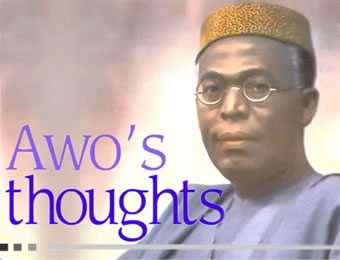
growth economic freedom Obafemi Awolowo Courage, Economic objectives, organisations
Continued from last week
IT is generally agreed that the phrase DEVELOPING COUNTRY
is euphemistic either in current use to distinguish an economically backward and ul}derdeveloped country from an economically developed and advanced one.
The chief common feature of all backward, or underdeveloped, or developing countries is extreme poverty.
For better understanding and near-mathematical accuracy, economists have chosen a more or less arbitrary criterion for identifying backward or developing as well as developed or advanced countries. Their yardstick is the United States of America.
I f the income per head of a country falls below one-quarter of the income per head in the USA, then that country is said to be backward, underdeveloped, or developing. It must be emphasised that the phrase has no political import or denotation at all.
Applying this yardstick, and having regard to available national income data of all the countries of the world, it is easy to discern and declare that developing countries are to be found mostly in Africa, Latin America, the Middle East, and the Far East. In the face of this, it becomes obvious that there is a very strong nexus between political instability with its accompanying necessity for constitutional changes, and economic backardness and poverty.
Constitution-making-is, however, not a process confined to developing countries only. Now and again, some developed countries do give themselves new constitutions: as was, for instance, the case with Japan in 1946, Austria in 1955, and France in 1958.
There are three types of constitution. They are unitary, federal and con federal.
Under a unitary constitution, the supreme legislative power in the state is vested in a single authority. Whereas under a federal constitution, the supreme legislative power in the composite state is shared between the central authority on the one hand, and the regional authorities on the other, all of which are co-ordinate with and independent of one another in the discharge of the functions expressly, or by necessary implication, vested in them by the consti tution. .
A confederal constitution is easily distinguished from a federal constitution. While the central and regional authorities under a federal constitution are co-ordinate and independent of one another, under a con federal constitution, the central authority is, to a large extent, dependent on the regional authorities. In other words, the central authority is neither co-ordinate with nor independent of the regional authorities. For all practical purposes, it owes its existence to the sufferance of the regional authorities.
A federal and a con federal constitution is invariably a written constitution, for the simple reason that the division of functions between the central and regional authorities which is inevitable, together with the attendant numerous provisions, cannot be left to what Harold Laski has graphically termed as the ‘hazards of human memory.’
As has been noticed, one of the things that a constitution does is to prescribe the organs of government.
There are, however, several forms of government from among which constitution-makers can choose. Some of them, which are :~tll1 in’ current use ‘in different parts of the world, are oligarchy, autocracy, tyrannyand democracy.
It may be noted, in passing, that all forms of government can be found uhder two mutually exclusive species of government, namely: monarchical, and republican.
“TIVe primary airnsand objects Of a state are – defence against external aggression, and the maintenance of internal peace, order and security. In modern times, these primary aims have been tremendously extended to include the economic prosperity and social welfare of the people.
The growing menace of rape
FUNDAMENTAL FACTORS
From what we have said, the following FOUR fundamental factors emerge for very careful and serious consideration by all those who are called upon to make a constitution for a developing country, or for any country for that matter, namely:
1) The composition of the state;
2) The type of constitution that is suitable;
3) The aims and objects of the state; and
4) The form of government.
We will take these four factors one by one, and treat them in the order in which we have stated them.
THE COMPOSITION OF THE STATE: The first thing to ascertain is whether or not the state consists of more than one nation or linguistic group. This is of extreme importance. Because an error in this regard may lead to a more or less permanent state of friction and ‘disharmony within the state concerned.’
To be continued
To Advertise or Publish a Story on NaijaLiveTv:
Kindly contact us @ Naijalivetv@gmail.com
Call or Whatsapp: 07035262029, 07016666694, 08129340000







